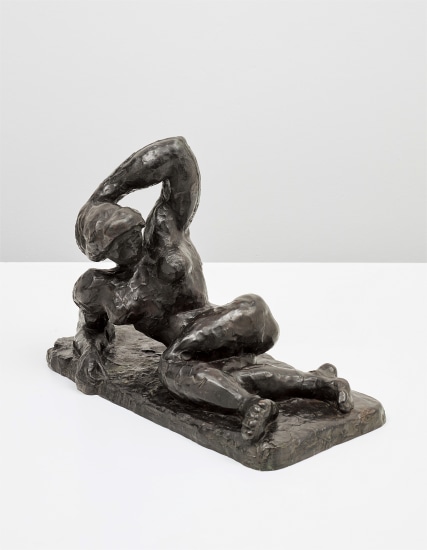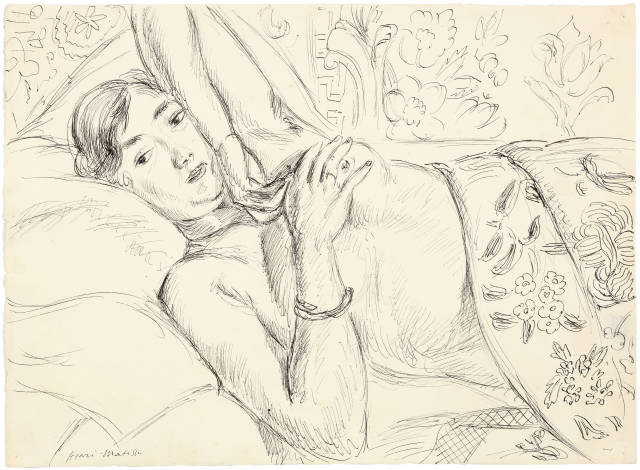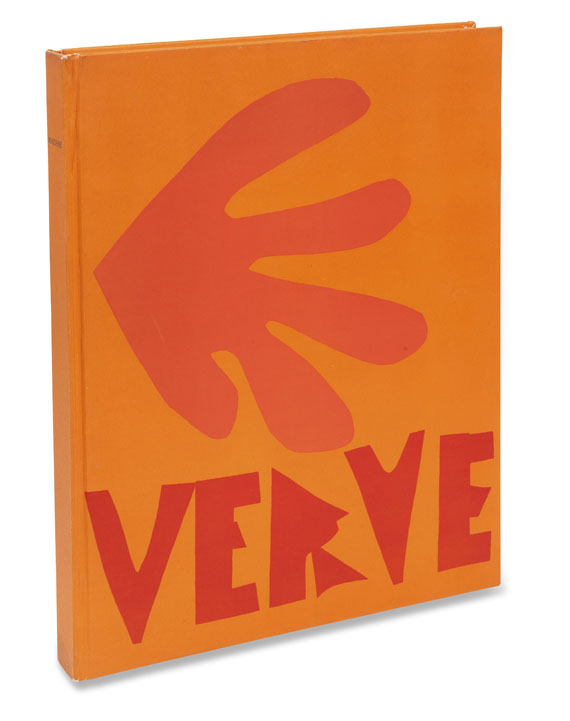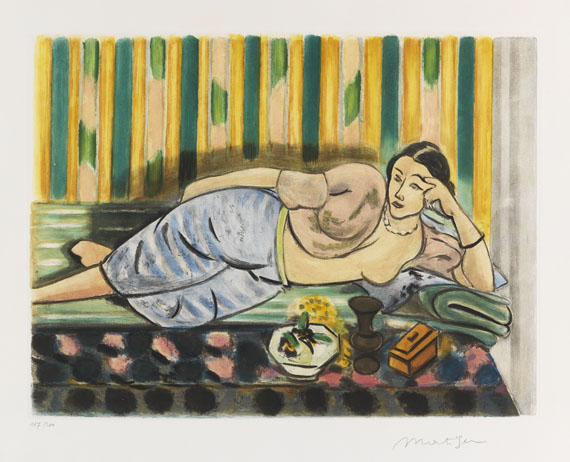HENRI MATISSE (1869-1954)Femme couchée de la serie 'Thèmes et variations', D4 signed, numbered and dated 'D4 Henri Matisse 41' (lower left) pen and India ink on paper 40.7 x 52.7cm (16 x 20 3/4in). Executed in 1941 FootnotesThe authenticity of this work has been confirmed by Georges Matisse. Provenance The artist's estate, France. Galerie Daniel Malingue, Paris (acquired from the above). Fondation Capa, Geneva, no. 19/39. Galerie Herbage, Cannes. Waddington Galleries, London, no. B 8907. Private collection, London (acquired from the above on 9 October 1981). Thence by descent to the present owner. Exhibited Cannes, Galerie Herbage, Henri Matisse Dessins, Lithographies, Scupltures, Collage, 1906-1952, 31 March – 27 June 1981, no. 18. Literature H. Matisse, Dessins, Thèmes et variations, Paris, 1943 (illustrated). Femme couchée de la serie 'Thèmes et variations', D4 is an arresting example of Matisse's mastery of drawing, its sensuous lines and seductive subject belying the personal circumstances of the artist, who was undergoing a long recovery from illness during the early years of German occupation. From January 1941 Matisse underwent numerous surgeries in Lyon to remove a tumour, before returning to Nice to convalesce at the Hôtel Regina in the Quartier Cimiez where he remained until June 1943. The artist started a series of interviews with Pierre Courthion on 5 April 1941, planning to release a publication. Continuing these interviews after his return to Nice in May, he told Courthion, 'it's like a rebirth, and I now consider time in a completely different way than before the operation. Now I'm more balanced' (Matisse quoted in J. Flam, Matisse on Art, Berkeley, 1995, p. 234). Suffering a painful recovery, Matisse was unable to sit up for long periods or paint in front of an easel. Confined to his bed, drawing became increasingly important as a means of expression and he managed to work by resting a drawing board against a rolling table attached to his bed. From late 1941 to early 1942 he focused almost exclusively on a series of charcoal, ink and pencil drawings from which he would form the now-famous portfolio entitled Dessins: Thèmes et Variations, printed in 1943 with a preface by Louis Aragon. Writing to his son Pierre during this time, Matisse explained: 'For a year now I have been making an enormous effort in drawing. I say effort but that's a mistake, because what has occurred is a "floraison" [flowering] after fifty years of effort' (Matisse quoted in J. Elderfield, The Drawings of Henri Matisse exh. cat., London, 1985, p. 16). Executing an astonishing 158 drawings within this time frame, Matisse would start with a charcoal drawing (his 'theme') and then explore related variations. Seventeen themes were chosen, lettered A-P, with each then inspiring between three and nineteen variations. Each variation allows an insight into the artist's process of refinement. Using both his primary model Lydia Delectorskaya and his nurse, Monique Bourgeois, as models, eleven of the themes were focused on elegant female portraits such as the present work, while the remaining six depicted still lifes. The subject of the female model was long established in Matisse's oeuvre and his oil canvases of the 1930s had seen an increasing move towards a distillation of form, seen in works such as Reclining Nude, 1935 (housed in The Barnes Foundation, Philadelphia) whose composition is conjured from simple, flattened planes of colour. Colour is cast away in Thèmes et variations however, allowing Matisse to focus purely on line, celebrating his belief that drawing was the foundation of pictorial art. In the present work, Matisse allows the ink lines to vary in thickness and pressure, revelling in the differing rhythms his hand produces, creating heavier strokes under the model's hair and emphasising the bold 'S' which denotes the sweep of her resting hand. There is a deceptive effortlessness to the composition – the sitter's bracelet is forme
HENRI MATISSE (1869-1954)Femme couchée de la serie 'Thèmes et variations', D4 signed, numbered and dated 'D4 Henri Matisse 41' (lower left) pen and India ink on paper 40.7 x 52.7cm (16 x 20 3/4in). Executed in 1941 FootnotesThe authenticity of this work has been confirmed by Georges Matisse. Provenance The artist's estate, France. Galerie Daniel Malingue, Paris (acquired from the above). Fondation Capa, Geneva, no. 19/39. Galerie Herbage, Cannes. Waddington Galleries, London, no. B 8907. Private collection, London (acquired from the above on 9 October 1981). Thence by descent to the present owner. Exhibited Cannes, Galerie Herbage, Henri Matisse Dessins, Lithographies, Scupltures, Collage, 1906-1952, 31 March – 27 June 1981, no. 18. Literature H. Matisse, Dessins, Thèmes et variations, Paris, 1943 (illustrated). Femme couchée de la serie 'Thèmes et variations', D4 is an arresting example of Matisse's mastery of drawing, its sensuous lines and seductive subject belying the personal circumstances of the artist, who was undergoing a long recovery from illness during the early years of German occupation. From January 1941 Matisse underwent numerous surgeries in Lyon to remove a tumour, before returning to Nice to convalesce at the Hôtel Regina in the Quartier Cimiez where he remained until June 1943. The artist started a series of interviews with Pierre Courthion on 5 April 1941, planning to release a publication. Continuing these interviews after his return to Nice in May, he told Courthion, 'it's like a rebirth, and I now consider time in a completely different way than before the operation. Now I'm more balanced' (Matisse quoted in J. Flam, Matisse on Art, Berkeley, 1995, p. 234). Suffering a painful recovery, Matisse was unable to sit up for long periods or paint in front of an easel. Confined to his bed, drawing became increasingly important as a means of expression and he managed to work by resting a drawing board against a rolling table attached to his bed. From late 1941 to early 1942 he focused almost exclusively on a series of charcoal, ink and pencil drawings from which he would form the now-famous portfolio entitled Dessins: Thèmes et Variations, printed in 1943 with a preface by Louis Aragon. Writing to his son Pierre during this time, Matisse explained: 'For a year now I have been making an enormous effort in drawing. I say effort but that's a mistake, because what has occurred is a "floraison" [flowering] after fifty years of effort' (Matisse quoted in J. Elderfield, The Drawings of Henri Matisse exh. cat., London, 1985, p. 16). Executing an astonishing 158 drawings within this time frame, Matisse would start with a charcoal drawing (his 'theme') and then explore related variations. Seventeen themes were chosen, lettered A-P, with each then inspiring between three and nineteen variations. Each variation allows an insight into the artist's process of refinement. Using both his primary model Lydia Delectorskaya and his nurse, Monique Bourgeois, as models, eleven of the themes were focused on elegant female portraits such as the present work, while the remaining six depicted still lifes. The subject of the female model was long established in Matisse's oeuvre and his oil canvases of the 1930s had seen an increasing move towards a distillation of form, seen in works such as Reclining Nude, 1935 (housed in The Barnes Foundation, Philadelphia) whose composition is conjured from simple, flattened planes of colour. Colour is cast away in Thèmes et variations however, allowing Matisse to focus purely on line, celebrating his belief that drawing was the foundation of pictorial art. In the present work, Matisse allows the ink lines to vary in thickness and pressure, revelling in the differing rhythms his hand produces, creating heavier strokes under the model's hair and emphasising the bold 'S' which denotes the sweep of her resting hand. There is a deceptive effortlessness to the composition – the sitter's bracelet is forme


.jpg)



.jpg)







Testen Sie LotSearch und seine Premium-Features 7 Tage - ohne Kosten!
Lassen Sie sich automatisch über neue Objekte in kommenden Auktionen benachrichtigen.
Suchauftrag anlegen